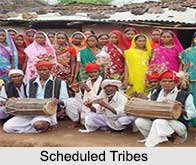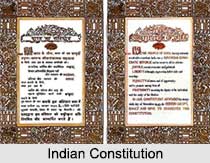 Scheduled Tribes (STs) are spread across the forest and hilly regions of India like Madhya Pradesh, Maharashtra, Odisha, Bihar, Andhra Pradesh, West Bengal and Gujarat. The crucial features of these communities are ancient characteristics, geographical separation, idiosyncratic culture, timidity of contact.
Scheduled Tribes (STs) are spread across the forest and hilly regions of India like Madhya Pradesh, Maharashtra, Odisha, Bihar, Andhra Pradesh, West Bengal and Gujarat. The crucial features of these communities are ancient characteristics, geographical separation, idiosyncratic culture, timidity of contact.
Indian Constitution and Development of Scheduled Tribes
The founders of Indian constitution were responsive of their problems and made special conditions for their fortification and improvement. The main safeguards of Scheduled Tribes include the sponsorship of educational and economic interests and their security from social injustices and all forms of development. The constitution presents special representation for the STs in the Lok Sabha and State legislative assemblies till 25th January, 2010 and commands the setting up of separate departments in the States and National Commission at the Centre to help their welfare. Later on with a view to successfully deal with the crimes against the Scheduled Tribes, two special laws "Protection of Civil Rights Act 1955" and the "Scheduled Castes, Scheduled Tribes (Prevention of Atrocities) Act 1989" were passed.
Special economic development of the Scheduled Tribes and protection against their exploitation has been an important programme of the Government. To certify that the legitimate mandates, high precedence for the welfare and development of Scheduled Tribes right from the beginning of the First Five Year Plan is being on agreement. Recognising their special problems the principles of "Panchsheel" have been adopted in the welfare and development of these communities. An essential landmark was opening of 43 Special Multipurpose Tribal Blocks (SMPTBs) in the Second Five Year Plan, later called Tribal Development Blocks (TDBs). Further, an important step in this bearing was taken in the Fourth Five Year Plan when six pilot projects in Andhra Pradesh, Bihar, Madhya Pradesh and Odisha were set up in the Central sector. A separate Tribal Development Agency was established for each project. The Commissions and Committees selected by the Government to check the tribal state of affairs brought to its notice that the percolation theory had not helped the tribal population.
 The Tribal Sub-Plans for Scheduled Tribes
The Tribal Sub-Plans for Scheduled Tribes
The Fifth Five Year Plan marked a move when the Tribal Sub Plan (TSP) for the direct advantage of the STs was launched. The Tribal Sub-Plan for the Scheduled Tribes was designed to channelize the flow of expends and benefits from the general sectors in the plans of the States and Union Territories (UTs) and Central Ministries in amount to their population. It is mainly an area development curriculum with focus on tribal under which infrastructural development and family- oriented programmes are undertaken.
The Ministry of Tribal Affairs is a preservative to the Tribal Sub Plan of the States and UTs and grants under Article 275 (1) of the Constitution for raising the level of infrastructure in the Scheduled Areas and economic development of the Scheduled Tribes. It is also executing different Centrally-sponsored and Central sector schemes under which monetary assistance is given to the States and UTs for the construction of hostels and coaching of ST students for competitive examinations and the development of their worth, research and training, setting up of ashram schools, professional training centres, village grain banks, educational complexes for ST girls and the development of primitive tribal groups. Besides this, non-governmental organisations (NGOs) have also been involved in the development of STs.
With the main purpose of providing marketing support and remunerative prices to the tribal population for their minor forest produce (MFP) and surplus agricultural produce (SAP) and to wean them away from exploitative private traders, the Tribal Cooperative Marketing Development Federation (TRIFED) was set up by the Government in the year 1987. The Government is working hard towards a new social order based on social equality and social harmony.
Constitutional Remedies for Scheduled Tribes
Following are the different Constitutional Remedies for the Scheduled Tribes:
•Article 330 of the Indian Constitution states the Reservation of seats for Scheduled Castes and Scheduled Tribes in the House of the People.
•Article 332 of the Indian Constitution states the Reservation of seats for Scheduled Castes and Scheduled Tribes in the Legislative Assemblies of the States.
•Article 334 of the Indian Constitution states the Reservation of seats and special representation to cease after sixty years.
•Article 243D of the Indian Constitution states the Reservation of seats (in Panchayats).
•Article 164(1) provides that in the States of Chhattisgarh, Jharkhand, Madhya Pradesh and Odisha there shall be a Minister in charge of tribal welfare who may in addition be in charge of the welfare of the Scheduled Castes and backward classes or any other work.
•Article 371A has special provisions with respect to the State of Nagaland.
•Article 371B has special provisions with respect to the State of Assam.
•Article 371C has special provisions with respect to the State of Manipur.
•Article 371F has special provisions with respect to Sikkim.
















